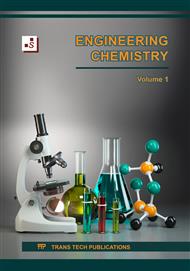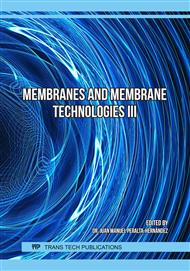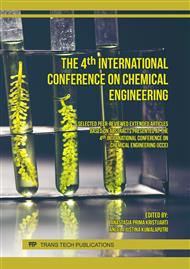[1]
F. Johnsson, J. Kjärstad and J. Rootzén, The threat to climate change mitigation posed by the abundance of fossil fuels, Clim. Policy 19/2 (2019) 258–274.
DOI: 10.1080/14693062.2018.1483885
Google Scholar
[2]
N. Abas, A. Kalair and N. Khan, Review of fossil fuels and future energy technologies, Futures 69 (2015) 31–49.
DOI: 10.1016/j.futures.2015.03.003
Google Scholar
[3]
J. Shen, K.H. Michaelian, R. Gieleciak, M.L. Baesso, N.G.C. Astrath, L. Malacarne, Photothermal characterization of biodiesel and petroleum diesel fuels—A review and perspective, J. Appl. Phys. 128 (2020) 190902.
DOI: 10.1063/5.0029235
Google Scholar
[4]
J.V. Gerpen, Biodiesel processing and production, Fuel Process. Technol. 86, 1097– 1107 (2005).
Google Scholar
[5]
V. B. Veljković, I. B. Banković-Ilić and O. S. Stamenković, Purification of crude biodiesel obtained by heterogeneously-catalyzed transesterification, Renew. Sustain. Energy Rev. 49 (2015) 500–516.
DOI: 10.1016/j.rser.2015.04.097
Google Scholar
[6]
N. Sdrula, A study using classical or membrane separation in the biodiesel process, Desalination 250, 1070–1072 (2010)
DOI: 10.1016/j.desal.2009.09.110
Google Scholar
[7]
S.S. Rahayu and A. Mindaryani, Optimization of biodiesel washing by water extraction, Proceedings of the World Congress on Engineering and Computer Science (2007) ISBN:978-988-98671-6-4.
Google Scholar
[8]
R. Jaber, M.M.A Shirazi, J. Toufaily, A.T. Hamieh, A. Noureddin, H. Ghanavati, A. Ghaffari, A. Zenouzi, A. Karout, A.F. Ismail, M. Tabatabaei, Biodiesel wash-water reuse using microfiltration: toward zero-discharge strategy for cleaner and economized biodiesel production, Biofuel Res. J. 5 (2015) 148-151.
DOI: 10.18331/brj2015.2.1.3
Google Scholar
[9]
H. Bateni, A. Saraeian, C. Able, A comprehensive review on biodiesel purification and upgrading, Biofuel Res. J. 15 (2017) 668-690.
DOI: 10.18331/brj2017.4.3.5
Google Scholar
[10]
R. Delcolle, M.L. Gimenes, C.A. Fortulan, W.M. Moreira, M.D. Martins, N.C. Pereira, A comparison between coagulation and ultrafiltration processes for biodiesel wastewater treatment, Chem. Eng. Trans. 57 (2017) 271-276.
Google Scholar
[11]
R.W. Baker, Membrane Technology and Applications 2nd Edition, John Wiley and Son, 2004, England.
Google Scholar
[12]
J. Saleh, A. Y. Tremblay and M. A. Dubé, Glycerol removal from biodiesel using membrane separation technology, Fuel 89/9 (2010) 2260–2266.
DOI: 10.1016/j.fuel.2010.04.025
Google Scholar
[13]
Y. Wang, X. Wang, Y. Liu, S. Ou, Y. Tan, S. Tang, Refining of biodiesel by ceramic membrane separation, Fuel Process. Technol. 90 (2009) 422-427.
DOI: 10.1016/j.fuproc.2008.11.004
Google Scholar
[14]
J. Saleh, M. A. Dubé, and A. Y. Tremblay, Separation of glycerol from FAME using ceramic membranes, Fuel Process. Technol. 92/7 (2011) 1305–1310.
DOI: 10.1016/j.fuproc.2011.02.005
Google Scholar
[15]
M. C. S. Gomes, N. C. Pereira and S. T. D. de Barros, Separation of biodiesel and glycerol using ceramic membranes, J. Membr. Sci. 352/1–2 (2010) 271–276.
DOI: 10.1016/j.memsci.2010.02.030
Google Scholar
[16]
I.M. Atadashi, M.K. Aroua, A.R.A. Aziz, N.M.N. Sulaiman, Crude biodiesel refining using membrane ultra-filtration process: An environmentally benign process, Egypt. J. Pet. 24/ 4 (2015) 383-396.
DOI: 10.1016/j.ejpe.2015.10.001
Google Scholar
[17]
S. P. Kusumocahyo and M. Sudoh, Pervaporation of Acetic Acid-Water Mixture Using Silica Membrane Prepared by Sol-Gel Method, J. Eng. Technol. Sci. 48/1 (2016) 99-110.
DOI: 10.5614/j.eng.technol.sci.2016.48.1.8
Google Scholar
[18]
M. Meliyanti, S. P. Kusumocahyo, E. Maryani, and H. Hermawan, Ceramic membrane development and characterization for microfiltration, AIP Conf. Proc. 2024 (2018).
DOI: 10.1063/1.5064344
Google Scholar
[19]
P. Bondioli, L.D. Bella, An alternative spectrophotometric method for the determination of free glycerol in biodiesel, Eur. J. Lipid Sci. Technol. 107 (2005) 153–157.
DOI: 10.1002/ejlt.200401054
Google Scholar
[20]
S.P. Kusumocahyo, S.K. Ambani, S. Marceline, Improved permeate flux and rejection of ultrafiltration membranes prepared from polyethylene terephthalate (PET) bottle waste, Sustain. Environ. Res. 31/19 (2021) 1-11.
DOI: 10.1186/s42834-021-00091-x
Google Scholar
[21]
H. Chang, H. Liang, F. Qu, J. Ma, N. Ren, G. Li, Towards a better hydraulic cleaning strategy for ultrafiltration membrane fouling by humic acid: Effect of backwash water composition, J. Environ. Sci. 43 (2016) 177–186.
DOI: 10.1016/j.jes.2015.09.005
Google Scholar
[22]
H. Wu, A. Kanora, D.K. Schwartz, Fouling of microfiltration membranes by bidisperse particle solutions, J Membr. Sci. 641 (2022) 119878.
DOI: 10.1016/j.memsci.2021.119878
Google Scholar
[23]
S.P. Kusumocahyo, S.K. Ambani, S. Kusumadewi, H. Sutanto, D. I. Widiputri, I.S. Kartawiria, Utilization of used polyethylene terephthalate (PET) bottles for the development of ultrafiltration membrane, J. Environ. Chem. Eng. 8/104381 (2020) 1-11.
DOI: 10.1016/j.jece.2020.104381
Google Scholar
[24]
A. Gul, J. Hruza, F. Yalcinkaya, Fouling and Chemical Cleaning of Microfiltration Membranes: A Mini-Review, Polymers 13/846 (2021) 1-25.
DOI: 10.3390/polym13060846
Google Scholar
[25]
H. Kwon, M. Lu and J. Lee, Optimization of hollow fiber membrane cleaning process for microalgae harvest, Korean J. Chem. Eng. 31 (2014) 949–955.
DOI: 10.1007/s11814-013-0276-4
Google Scholar




